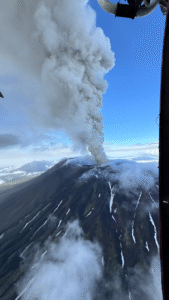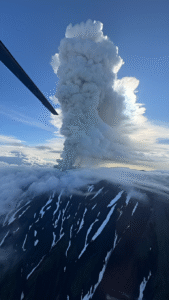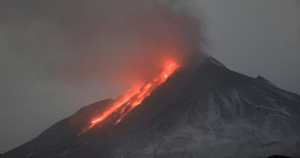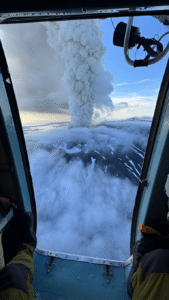
In a dramatic geological event, the long-dormant Krasheninnikov Volcano in Russia’s remote Kamchatka Peninsula has erupted for the first time in approximately 600 years, sending plumes of ash into the sky and raising concerns about regional volcanic activity possibly linked to a powerful earthquake that struck the region last week.
According to Russia’s RIA state news agency, the overnight eruption was confirmed by scientists on Sunday, marking a historic and scientifically significant occurrence. The Krasheninnikov Volcano, which had not erupted since around 1463, suddenly became active following a major earthquake in Russia‘s Far East that had ripple effects as far away as French Polynesia and Chile.
Olga Girina, head of the Kamchatka Volcanic Eruption Response Team, confirmed the historical significance of the eruption. Speaking to RIA, Girina noted, “This is the first historically confirmed eruption of krasheninnikov volcano in 600 years.” She also emphasized the potential connection between the recentseismic activity and the volcano’s unexpected reawakening.
Girina stated on the Telegram channel of the Institute of Volcanology and Seismology that the last known lava effusion from Krasheninnikov occurred around 1463, with a margin of error of 40 years. Since then, the volcano has remained quiet, with no records of any further eruptions until now.

The eruption closely follows the seartrong thquake that rocked Russia’s Far East on Wednesday, an event that triggered tsunami warnings across the Pacific, from the Kuril Islands to Chile. Though direct causation between the quake and the volcanic eruption has not been officially established, scientists are investigating the likelihood that the tectonic disturbance contributed to or triggered the volcanic activity.
In an unsettling coincidence, the eruption of Krasheninnikov was not the only volcanic event observed in the region following the earthquake. The Klyuchevskoy Volcano, known as the most active volcano in the Kamchatka Peninsula, also erupted shortly after the quake. The rapid succession of these geological events has added weight to scientific theories about earthquake-volcano interactions, especially in tectonically active regions like Kamchatka.

Ash Cloud Reaches 6,000 Meters
The Russian Ministry of Emergency Situations reported that the eruption of Krasheninnikov released a towering ash plume reaching up to 6,000 meters (approximately 3.7 miles) into the atmosphere. While the volcano itself stands at 1,856 meters, the ash cloud has already drifted eastward, moving toward the Pacific Ocean.
Fortunately, the ash cloud’s path does not currently intersect with any populated areas, minimizing immediate risk to local communities. Authorities continue to monitor the situation closely, given the potential for air traffic disruptions and environmental impacts.
The eruption has been assigned an orange aviation code, which is the second-highest warning level for volcanic activity. This code signals a heightened risk to aircraft, especially due to reduced visibility and the potential for ash to damage engines. Airlines flying over or near the Kamchatka Peninsula have been advised to exercise caution.
Kamchatka: A Volcanic Hotspot
The Kamchatka Peninsula is part of the Pacific Ring of Fire, one of the world’s most geologically active regions. Home to over 160 volcanoes, with 29 of them currently considered active, the peninsula regularly experiences volcanic eruptions and earthquakes. However, the awakening of a volcano like Krasheninnikov, dormant for centuries, is considered rare and noteworthy.

The Krasheninnikov Volcano, named after 18th-century Russian explorer Stepan Krasheninnikov, features a complex structure composed of two merged stratovolcanoes. Though it had been classified as dormant, the recent activity may prompt scientists to re-evaluate the status of other long-inactive volcanoes in the region.
Volcanologists have already begun to collect data and analyze satellite imagery to understand the full scope and potential future developments of the eruption. The initial phase of the eruption appears to be explosive, marked by ash ejection rather than lava flows, but this may change depending on underground magma movement.
Public Safety and Scientific Implications
While the eruption poses no immediate danger to residents, the event has heightened alertness in the Kamchatka region. Emergency services have been placed on standby, and monitoring systems are being reinforced across other nearby volcanoes.

Girina and other scientists warn that the situation remains fluid, and the region could see additional seismic or volcanic activity in the coming days or weeks. “We must continue to monitor not just Krasheninnikov, but the entire volcanic chain in Kamchatka,” she said.
For scientists, this eruption presents an invaluable research opportunity. Dormant volcanoes that awaken after centuries offer insights into deep-earth dynamics, magma chamber behavior, and the possible interactions between seismic and volcanic activity.
The eruption also underscores the global interconnectedness of natural systems. An earthquake in Russia’s Far East can lead to tsunamis in South America and volcanic eruptions in the Arctic. As climate and geological patterns evolve, scientists are urging better international cooperation and data sharing to improve early-warning systems and response capabilities.
